“Global Collision Avoidance System Market to reach a market value of USD 160.86 Billion by 2031 growing at a CAGR of 11.0%”
The Global Collision Avoidance System Market size is expected to reach $160.86 billion by 2031, rising at a market growth of 11.0% CAGR during the forecast period.
The Europe segment witnessed 35% revenue share in the market in 2023. This is driven by the region's strong automotive industry, stringent safety regulations, and increasing adoption of ADAS. The presence of major automotive manufacturers, coupled with government initiatives promoting vehicle safety and reduced road accidents, significantly contributed to market growth.
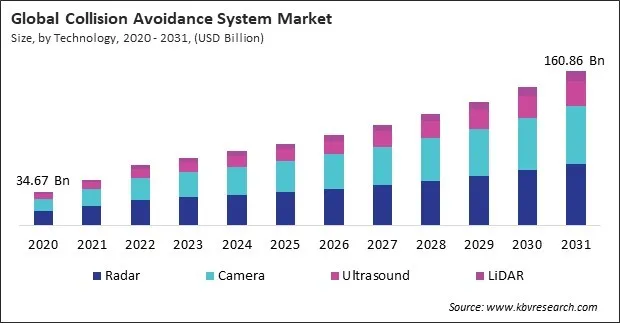
The growing adoption of Advanced Driver Assistance Systems (ADAS) in automobiles is a key driver for the market. Automakers are incorporating ADAS features such as automatic emergency braking (AEB), lane departure warning (LDW), adaptive cruise control, and blind-spot monitoring to enhance vehicle safety and reduce accident rates. Hence, Increasing ADAS in automobiles is driving the growth of the market.
Additionally, Government regulations worldwide are crucial in the adoption of these systems across the automotive and industrial sectors. Organizations such as the National Highway Traffic Safety Administration (NHTSA) in the U.S., the European New Car Assessment Programme (Euro NCAP), and the Bharat New Vehicle Safety Assessment Programme (BNVSAP) in India have introduced strict guidelines requiring vehicles to include certain safety features to receive high safety ratings. Thus, stringent government regulations and safety norms for these sectors are driving the market's growth.
However, The high upfront cost of these systems remains a significant barrier to widespread adoption. Advanced technologies such as LiDAR, radar sensors, high-resolution cameras, ultrasonic sensors, and artificial intelligence-based processing units drive up production costs, making these systems expensive for manufacturers and consumers. Thus, high initial costs and expensive integration of these systems in vehicles and equipment are hindering the market's growth.
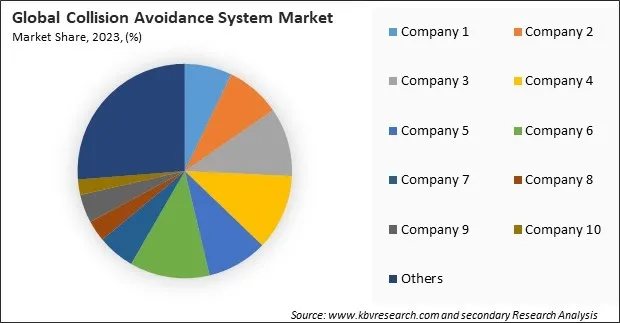
The leading players in the market are competing with diverse innovative offerings to remain competitive in the market. The above illustration shows the percentage of revenue shared by some of the leading companies in the market. The leading players of the market are adopting various strategies in order to cater demand coming from the different industries. The key developmental strategies in the market are Acquisitions, and Partnerships & Collaborations.
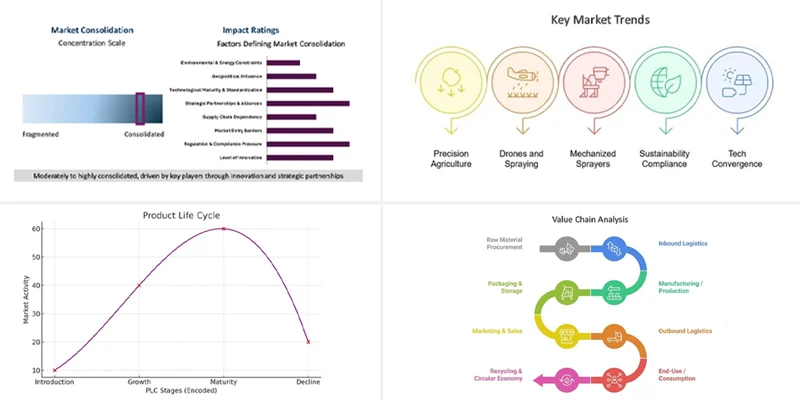
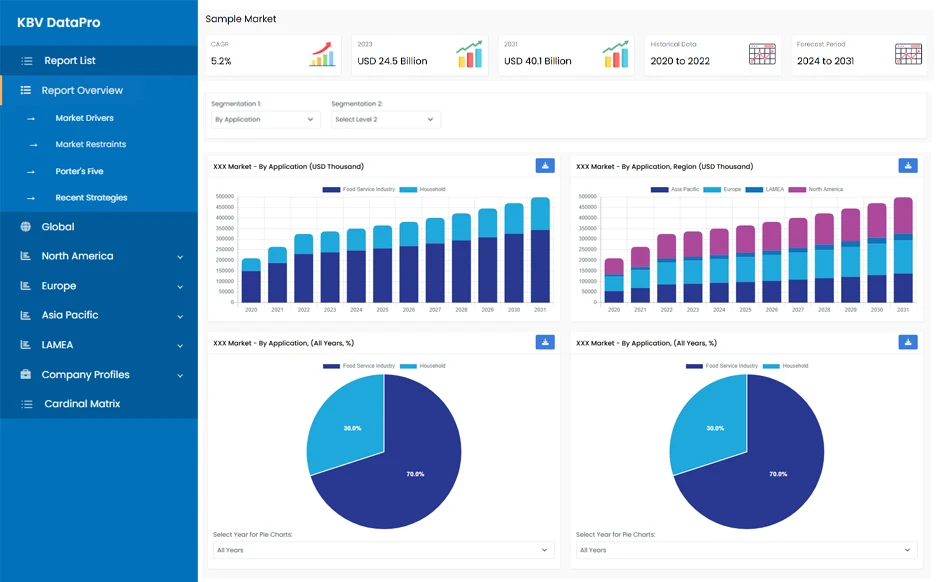
Based on technology, the market is characterized into radar, camera, ultrasound, and LiDAR. The LiDAR segment procured 6% revenue share in the market in 2023. The rising adoption of LiDAR technology in autonomous and semi-autonomous vehicles played a crucial role in this growth. LiDAR offers high-precision 3D mapping and object detection, making it a key component in advanced collision avoidance systems.
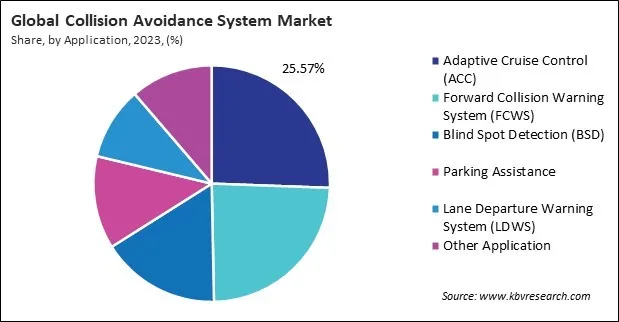
On the basis of application, the market is classified into adaptive cruise control (ACC), blind spot detection (BSD), forward collision warning system (FCWS), lane departure warning system (LDWS), parking assistance, and others. The forward collision warning system (FCWS) segment recorded 24% revenue share in the market in 2023. Rising concerns over road safety and accident prevention drive this. FCWS technology is increasingly integrated into passenger and commercial vehicles to help drivers detect potential front-end collisions and react in time, reducing the risk of crashes.
Free Valuable Insights: Global Collision Avoidance System Market size to reach USD 160.86 Billion by 2031
Region-wise, the market is analyzed across North America, Europe, Asia Pacific, and LAMEA. The North America segment recorded 32% revenue share in the market in 2023. This dominance was driven by the widespread adoption of advanced driver assistance systems (ADAS), stringent vehicle safety regulations, and the presence of key automotive manufacturers and technology providers. The United States and Canada played a crucial role in market expansion, with increasing investments in autonomous vehicle technology and smart transportation solutions further propelling growth.
| Report Attribute | Details |
|---|---|
| Market size value in 2023 | USD 70.50 Billion |
| Market size forecast in 2031 | USD 160.86 Billion |
| Base Year | 2023 |
| Historical Period | 2020 to 2022 |
| Forecast Period | 2024 to 2031 |
| Revenue Growth Rate | CAGR of 11.0% from 2024 to 2031 |
| Number of Pages | 242 |
| Number of Tables | 300 |
| Report coverage | Market Trends, Revenue Estimation and Forecast, Segmentation Analysis, Regional and Country Breakdown, Market Share Analysis, Porter’s 5 Forces Analysis, Company Profiling, Companies Strategic Developments, SWOT Analysis, Winning Imperatives |
| Segments covered | Technology, Application, Region |
| Country scope |
|
| Companies Included | Infineon Technologies AG, NXP Semiconductors N.V., Continental AG, DENSO CORPORATION, Aptiv PLC, Robert Bosch GmbH, Analog Devices, Inc., Murata Manufacturing Co., Ltd., Panasonic Holdings Corporation, and Alstom SA |
By Technology
By Application
By Geography
This Market size is expected to reach $160.86 billion by 2031.
Stringent Government Regulations and Safety Norms for Automotive and Industrial Sectors are driving the Market in coming years, however, High Initial Cost and Expensive Integration of Collision Avoidance Systems in Vehicles and Equipment restraints the growth of the Market.
Infineon Technologies AG, NXP Semiconductors N.V., Continental AG, DENSO CORPORATION, Aptiv PLC, Robert Bosch GmbH, Analog Devices, Inc., Murata Manufacturing Co., Ltd., Panasonic Holdings Corporation, and Alstom SA
The expected CAGR of this Market is 11.0% from 2023 to 2031.
The Radar segment led the maximum revenue in the Market by Technology in 2023, thereby, achieving a market value of $63.82 Billion by 2031.
The Europe region the Market by Region in 2023, thereby, achieving a market value of $54.02 Billion by 2031.
Our team of dedicated experts can provide you with attractive expansion opportunities for your business.
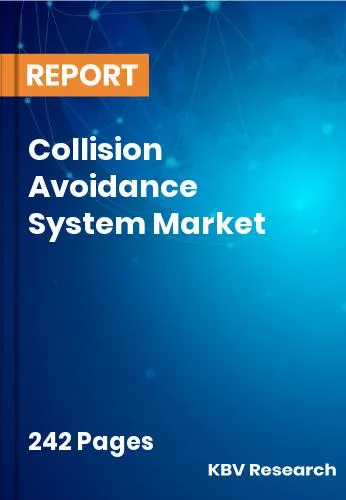
 Drivers
Drivers
 Restraints
Restraints
 Opportunities
Opportunities
 Challenges
Challenges
